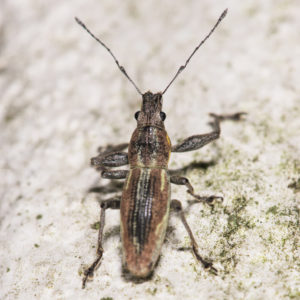The South American fruit tree weevil (Naupactus xanthographus) is a coleopteran with an elongated shaped body (11-15 mm in length). Newly emerged adults are reddish-brown but change to gray-brown. Thee elytra has narrow yellowish-white longitudinal bands. The elytra are broader in females than in males. Eggs are yellowish in color and are laid in masses. The apodous C-shaped larvae are white, then yellowish, and finally beige. The pupae are light colored and have free appendages.
Damage
Adults feed on the foliage, producing notches in the leaves, which in young plants can decrease photosynthetic efficiency, delaying crop development. The most important damage is caused by the larvae, which, by feeding on the root system, impair the absorption of water and nutrients, decreasing production. There are also indirect damages associated with the presence of eggs, for example under the calyx of citrus fruit, which can make the fruits and vegetables unmarketable.
There are specific natural enemies for beetles.
For more information contact your local BioBee field agent.












